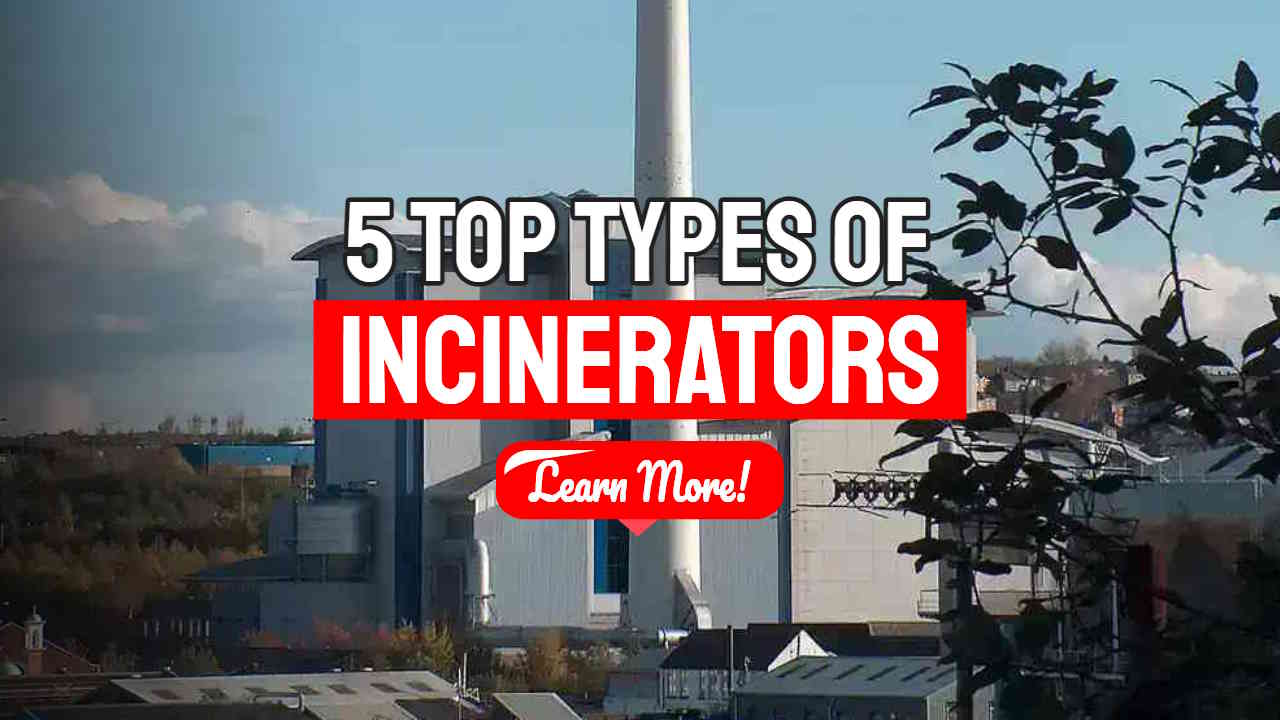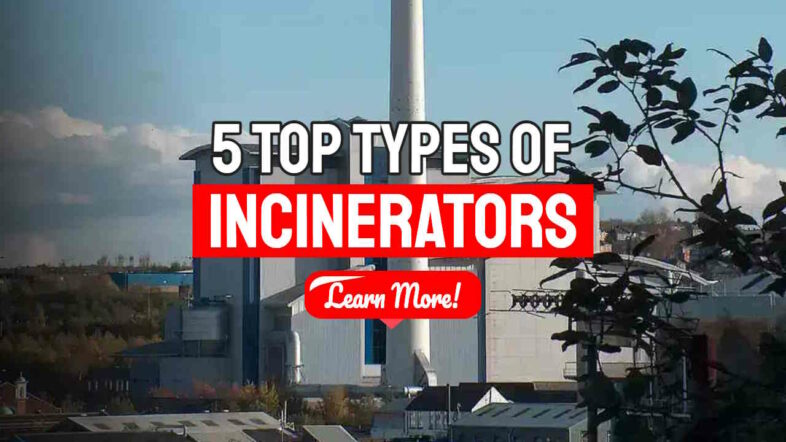Discover the different types of incinerators, the waste types they burn, and their unique benefits in waste management. Find the perfect solution for your specific needs!
From fixed grate to fluidized bed, explore the world of incineration technologies and find out which one suits your requirements best.
Understanding how we, as a society, handle waste is an important part of responsible environmental stewardship. A key component in modern waste management practices is the use of incinerators, machines designed to burn hazardous materials at high temperatures.
This article will delve into the details of different types of incinerators and their applications, shedding light on this vital aspect of our eco-friendly efforts. Ready to embark on your journey through the heated world of incineration technology?.
Incinerator Types – Takeaways
- Incinerators are machines used to burn hazardous materials at high temperatures as part of waste management practices. The largest incinerators are those that burn municipal solid waste (MSW).
Note: MSW is not classified as hazardous waste under the Waste Regulations, but unless it is combusted with great care and the flue gases are cleaned before they leave the chimney, the off-gas would be very hazardous. - Different types of incinerators when categorized according to the combustion chamber technology used, include fixed grate/direct flame, pyrolytic chamber, rotary kiln, single chamber, and fluidized bed incinerators.
- Each type has its own advantages and applications; for example, pyrolytic chamber incinerators are effective at treating medical and hazardous waste due to lower emissions.
- The use of incineration technology is vital for the proper disposal of medical waste, reducing landfill usage through municipal waste incineration, safely disposing of industrial waste, and providing the destruction of harmful substances from hazardous materials.

Types of Incinerators Categorised by Combustion Technology
1. Fixed Grate and Moving Grate Direct-Flame Incinerators
Fixed grate/moving grate or Direct-Flame incinerators are a very common type of large waste treatment plant. These mass-burn wastes right on the grate. Wastes like papers, food scraps, and wood in Municipal Solid Waste (MSP) can be burnt here.
Fixed Grate / Direct-Flame Incinerators burn waste on a stationary grate, with combustion occurring directly in contact with the waste.
Moving grate incinerators handle huge quantities of MSW by gently moving the burning rubbish down a gradient on an extremely tough type of metal conveyor. A rolling action induced into the burning mass ensures that the refuse is burnt right through, while ash, metal cans, etc., fall through the grating. Larger items such as metal pieces fall off the end of the moving grate
But one must keep in mind that incineration also creates large quantities of hazardous bottom ash and the flues must safely handle dangerous fly ash, which might pollute the air if not handled well.
A natural feature of the combustion process is that by adjusting the rate of air delivery, temperature, and pressure, different degrees of combustion occur and the output varies.
Mixed grate and moving grate direct-flame incinerators normally operate with an airflow sufficient to provide complete combustion. But the next type of incinerator works by restricting the airflow during combustion.
2. Pyrolytic Chamber Incinerators
Pyrolytic chamber incinerators are a type of waste management technology used to burn and treat different types of waste. In these incinerators, the waste is heated in an oxygen-limited environment, which leads to the release of combustible gases and the production of char.
The char can then be burned or converted into useful byproducts such as biochar. Pyrolytic chamber incinerators are effective at destroying hazardous materials and reducing the volume of solid waste.
They also have lower emissions compared to other types of incinerators, making them more environmentally friendly. These incinerators are commonly used for treating medical and hazardous waste, as well as organic waste from industries.
There is another type of combustion known as gasification during which the airflow is restricted and delivered both under pressure and the available air is always held somewhat below that needed for full combustion.
3. Rotary Kilns
Rotary kilns are a type of mass burn incinerator that use rotating drums to heat and burn waste. They are often used for industrial waste disposal. In a rotary kiln, the waste is placed inside the drum and heated to high temperatures, causing it to break down and turn into ash.
The rotating motion helps distribute the heat evenly throughout the waste, ensuring complete combustion. Rotary kilns are efficient in treating various types of waste, including hazardous materials and medical waste.
All incinerator types play an important role in waste management by reducing the volume of waste and minimizing its environmental impact.

4. Single Chamber Incinerators
Single chamber incinerators are a type of waste treatment facility that uses high temperatures to burn and destroy contaminants in solid waste. These incinerators have only one combustion chamber where the waste is burned.
They are commonly used for municipal solid waste, hazardous waste, and medical waste disposal. Single-chamber incinerators can efficiently reduce the volume of waste and minimize its environmental impact.
However, they produce ash that needs proper management to prevent pollution.
Incineration technology has both advantages and disadvantages, so it's important for environmental researchers, waste management professionals, government officials, sustainability advocates, energy companies, landfill operators, environmental engineers, and policymakers to carefully consider the pros and cons when deciding on the appropriate method of waste disposal.
5. Fluidized Bed Incinerators
Fluidized bed incinerators are a type of incineration technology used to treat different types of waste, including municipal solid waste and hazardous waste. These incinerators operate by suspending the waste on a bed of sand or other inert material, which is then heated to high temperatures.
This creates a “fluidized” state where the particles in the bed behave like liquids. The heat generated during this process effectively destroys contaminants and reduces the volume of waste.
Fluidized bed incinerators also have systems in place to control emissions and minimize environmental impact. They are considered effective for treating various types of waste and can be found in waste management facilities around the world.
Overview of Each Type of Incinerator
An Overview of Each Type of Incinerator:
Fixed Grate / Direct-Flame Incinerators:
These types of incinerators use a fixed grate to hold waste while it is directly exposed to an open flame. This technology is commonly used in small-scale facilities and is effective for the combustion of solid waste.
However, it may have limitations in effectively burning high-moisture or low-calorific-value waste.
Pyrolytic Chamber Incinerators:
Pyrolytic chamber incinerators utilize a sealed chamber where waste materials are heated in the absence of oxygen. The process produces gases, liquids, and solids that can be further processed or treated.
This type of incineration technology has advantages in terms of reducing emissions and producing valuable by-products such as biochar.
Rotary Kilns:
Rotary kiln incinerators involve rotating cylinders that allow for continuous feeding and combustion of waste materials. These systems are ideal for treating large quantities of waste with varying characteristics, including hazardous and industrial wastes.
They provide efficient thermal treatment while also minimizing the release of harmful pollutants.
Single Chamber Incinerators:
Single chamber incineration involves the combustion of waste within a single enclosed chamber without additional processing steps such as gasification or pyrolysis.
While this method is relatively simple, it may not achieve optimal emissions pollutant control compared to more advanced technologies.
Fluidized Bed Incinerators:
In fluidized bed incineration, air or another gas passes upward through a sand-like medium carrying suspended particles (typically fine-grained ash). This creates a turbulent mixing zone where solid particles come into contact with the heat source for thorough combustion.
Fluidized bed systems offer good heat transfer efficiency and high flexibility in handling different types of waste. But on the downside, they depend upon sophisticated active real-time control systems to constantly adjust airflow and the feed rate.
So, there you have it! Each type has its own set of advantages, disadvantages, and specific applications depending on the type and quantity of waste being treated. Understanding these different options allows for informed decision-making when implementing waste management strategies.
Applications and Uses
– Medical waste incineration is crucial for the proper disposal of potentially infectious and hazardous materials in healthcare facilities.
– Municipal waste incineration is an effective way to reduce the volume of solid waste, minimize landfill usage, and generate energy from waste-to-energy plants.
– Industrial waste incinerators are used to safely dispose of various types of industrial waste, including chemicals, solvents, and other hazardous materials.
– Hazardous waste incinerators are essential for the treatment and destruction of toxic substances that pose a significant risk to human health and the environment.
Medical Waste Incineration
Medical waste incineration is a crucial aspect of waste management. It involves burning medical waste, such as syringes and contaminated materials, at high temperatures to destroy harmful pathogens and reduce the volume of waste.
Incineration facilities specifically designed for medical waste treatment ensure that hazardous substances are safely disposed of without posing a risk to public health or the environment.
Medical waste incineration helps prevent the spread of diseases and reduces the impact on landfills. However, it is important to implement proper emissions control measures to minimize air pollution during this process.
Municipal Waste Incineration
An important strategy for controlling the growing amount of waste that cities produce while also creating energy is municipal waste incineration.
Municipal waste incineration is a method of treating waste by burning it in specialized facilities called incinerators. This process helps to reduce the volume of solid waste and generate energy.
It is commonly used for treating municipal solid waste, which includes household trash, paper, plastic, and food waste. With the use of incineration technology, hazardous substances can be destroyed at high temperatures.
However, this process produces ash that needs proper disposal to prevent air pollution.

Industrial Waste Incineration
Industrial waste incineration is a process used to burn and destroy hazardous materials produced by industries. It involves high-temperature combustion to eliminate contaminants and reduce the volume of waste.
Incinerators, also known as thermal treatment facilities, are used for this purpose. By burning industrial waste, harmful substances can be eliminated, reducing their impact on the environment.
However, it is important to note that incineration creates ash residues, including fly ash, which can cause air pollution if not properly managed. Despite its advantages in treating industrial waste, incineration also has disadvantages that need careful consideration before implementing this method of waste management.
Hazardous Waste Incineration
Hazardous waste incineration is a method of burning dangerous materials at very high temperatures to eliminate harmful substances. This process takes place in special facilities called incinerators or thermal treatment facilities.
Hazardous waste, which includes toxic chemicals and other harmful substances, is burned to destroy contaminants and reduce the environmental impact. Incineration helps prevent these hazardous materials from polluting the air, soil, and water systems.
It is an important method of waste management for industries that produce large amounts of hazardous waste. By using incineration, we can safely dispose of and manage these hazardous materials while minimizing their negative effects on the environment.

Conclusion to “5 Top Types of Incinerators”
In conclusion, there are different types of incinerators used for waste management. These include fixed grate, pyrolytic chamber, rotary kiln, single chamber, and fluidized bed incinerators.
Each type has its own benefits and is used for different applications, like medical waste disposal or industrial waste treatment. Understanding these different types can help in making informed decisions about waste disposal methods that minimize environmental impact.
FAQs About 5 Top Types of Incinerators
1. What is the waste incineration process?
The waste incineration process involves burning solid waste in combustion chambers at waste-to-energy (WtE) plants to reduce its size and hazardous properties.
2. Can you name a few types of incinerators?
Types of incinerators include municipal solid waste incinerators, medical waste incinerators, gasification incinerators, and pyrolysis incinerators.
3. How does waste reduction happen in these types of incinerators?
Waste reduction in these types of incinerators happens through the combustion process which turns the bulky trash into ash for easy disposal.
4. Do all types of incinerators have pollution control methods?
Yes! All types of duly operated incinerators include secondary combustion chambers and other pollution control methods to limit harm to the environment, from renewable waste to energy processes.





